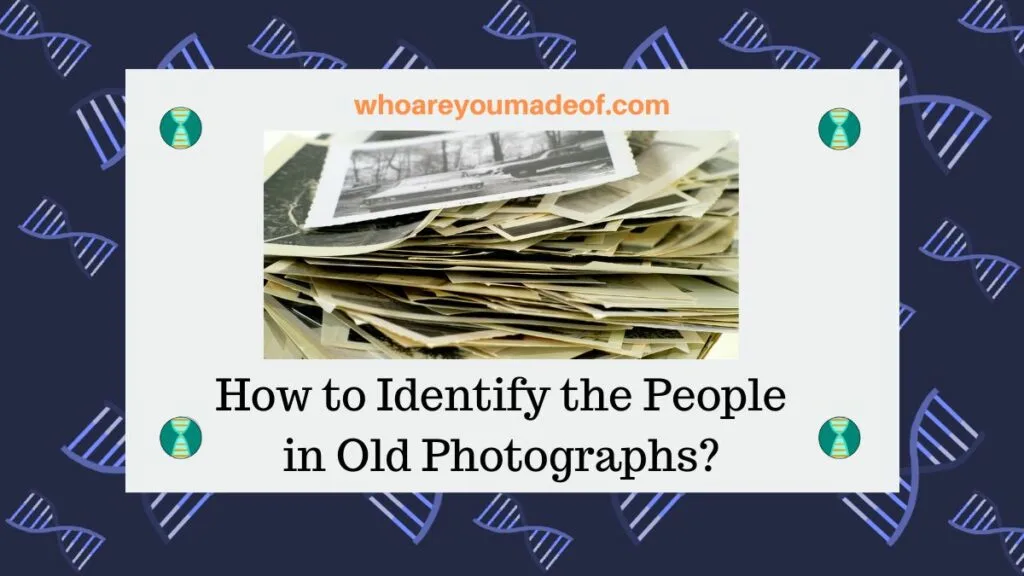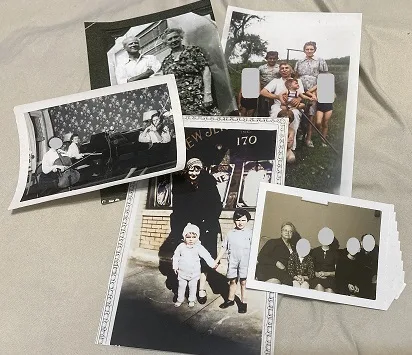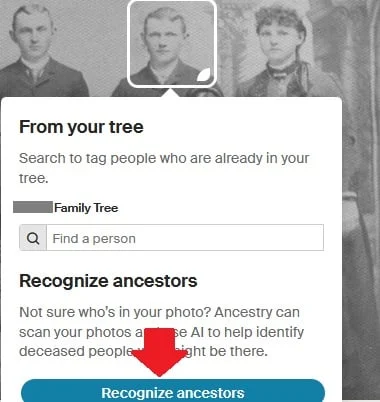Do you have a pile of old photographs of people that you can't identify? In this post, learn how you can figure out who these people are so you can preserve their image for future generations.

Over the past several years, I have come to acquire dozens of old pictures of family members. Some of these relatives are recent relatives, and I remember who they are, but many of the pictures are of people who I never met.
If you have old photographs like this, too, you realize how lucky you are to have them. However, it's frustrating when you don't know who all of the people in the pictures are.
We all want to do the right thing and digitize or preserve the photos in some way, such as by adding them to our Ancestry family tree for other relatives to see. However, in order to do this we must know who is in the photo.
Why is it important to identify who is in old photographs?
One of the top reasons that we should try to identify the people in old pictures is because it will not become any easier with the passing of more time. If you and I do not try to figure out who is in our photos, our children and grandchildren will have an even more difficult time trying to do so.
Furthermore, if we do not know who the people are in the pictures, we will not be able to save the photos in a meaningful way for future generations. If we know who the people are, however, we can make sure that the photos end up with those who would appreciate them the most, whether it be as a physical photo or digitized image.
Tips for identifying the people in old photographs
The image below is just a tiny selection of photographs that I have where I am unsure of the identity of at least one of the people. There are some tips that I can follow to figure out who the other members of the group are, however, which you will find if you keep reading.

Are there clues in these pictures that I could use to help me identify each and every person? There sure are!
Look for writing on the photo
Any writing that is on the photograph is going to provide the best foundation of information about the picture. Even if the photo doesn't list names, details such as a date, initials, or any other note will help point us in the right direction.
For example, in one of the photos that I showed in the collage above, my great-great grandfather is shown with several children sitting around him. On the back of the photo it says "Papa, at the farm, a few months before he died."
Immediately, I know the year the photograph was taken and a good clue about the location.
Ask your older relatives
One of the very first things that we should do when we have an old picture with unknown subjects is to ask an older relative for help. It is crucial that we do this as soon as we discover a question about a photograph, since our older relatives often have information and personal experiences that may help them answer a question about a photograph very quickly.
The older relative could be someone from a previous generation, but it could also be an older sibling or cousin who can provide additional information about an event or memory.
Use where the photo was stored as a clue
Making a list of who the relatives might be can help you narrow down the possibilities. You can use information that you already have, such as where the photograph was found, to help you.
For example, if you found it in a box that belonged to your mother and it was stored with letters from her paternal grandmother, then you might be able to work on the theory that the people in the photo are related on her paternal grandmother's line of the family tree.
Or, if the photograph was stored with a letter from a cousin, perhaps the people in the picture are her children or grandchildren. If the photo was in an old desk that came from your great aunt's living room, maybe they are related to her in some way?
Look at your family tree
If we think that the people in the photograph are somehow related to us, then having a family tree to refer to will be helpful. Having a family tree can help us work out names and locations very quickly, which can help with old photos.
For example, if you have a photograph that says "Cousin Robert and children" on the back, then in order to identify the people in the picture, you will need to know how "Cousin Robert" is related to you, and the names of his children.
Some people have not begun building their tree, or do not include extended relatives in their tree. If you have not started your tree, then you might want to read about how to build a tree or why you should include extended family.
Refer to family stories
Family stories can often be a source of clues about old pictures. This could help you narrow down a time frame, location, or other important clues about who is in the photo.
Maybe you remember hearing about your grandmother attending the Chicago World's Fair, and you have a photo of your grandmother and an identified child standing in front of some sort of "sky gondola". If you connect the story with the photo, the "gondola" becomes the "Sky Ride", and you will realize that the photo was at the fair, and the other child was born before 1934-35 because of the year of the fair.
This could turn out to be a good clue.
Estimate the date of the photograph
As you may have already guessed, the date of the photograph is a very important detail to learn. Knowing the date can help us eliminate some of our ideas about who the people in it may be, and give us more ideas about how to determine the subject.
There are many ways to estimate the date of when a picture was taken:
- Who else is in the photograph?
- Examine the type of photograph
- How are people dressed?
- What technology is visible?
- Is the photograph color?
- Type of paper
Any detail, no matter how small, can be helpful in dating a photograph.
Find context in the picture
Photographs used to be very expensive to take, and so many families only took photographs during important gatherings or events. This means that there may be clues in the photograph that can help you figure out why the photograph was taken.
Look at buildings and landmarks
Buildings and landmarks visible in photographs can often provide clues about time and place for photos because cities and towns change over time. We can often spot a building that is no longer there, or that had recently been built, in order to narrow down some of our options.
If your photograph was taken in a town or city, you can often find historical societies or websites that are dedicated to history of a place. You might be able to find photographs of old streets or even homes, which you can then compare to your photo.
Look at photographer studio name
If a photograph was professionally done, then you might be able to research the photographer to learn when their studio was active and where it was located. This can help you determine time and place, as well as narrow down your options for a photograph.
Occasionally, we might not even need to have the photograph be labeled with the name of the studio to know who likely took it. It is possible that the photographer was the only one in the area, or had a very distinctive studio, or a special style of photographer that makes their photos easy to identify.
Earlier this year, I came into the possession of a few old tintype photographs of ancestors from the 1860s. I know that these ancestors lived in Orange County, NY, and there was only one photographer in that area doing tintype photos during that time.
Sure enough, the styles of the photographs from his studio are very similar to those that I have of my ancestors. This knowledge can help me identify the subjects of other tintype photos that were stored in the same box.
Employ facial recognition technology
If you have many old photographs, know who some of the people are, and are good with technology, you can harness the power of racial recognition to help you identify the people in your pictures. This technology is very advanced and has improved vastly over the past few years, and can even identify people at different ages in their life.
Google photos
Google Photos is a free website where you can upload digital scans of your old photos. Then, you can "tag" each person in the photographs that you are able to identify.
I have been using Google for photo storage for more than a decade. I started way back when the Picasa was the coolest way to organize photos.
As you upload new photographs, Google Photos will then use AI (artificial intelligence) to automatically identify anyone that it can. The more identifications you can make, the higher the probability that the software will be able to identify your relatives at different ages in other photographs.
Google photos has very good technology for facial recognition, even when the people in the photos are at different ages. For example, I am able to search for photos of my young adult children and I get photos of them as toddlers in my results.
While it does take some time to scan and upload the photos, it is a worthy endeavor because it has the potential to save you significant time. Plus, you can always upload those scanned photographs to your family tree while you are at it.
Ancestry's AI "Recognize Ancestors" feature
Ancestry launched an AI photo recognition "tagging" feature in 2024. The goal of this feature is to be able to attempt to identify the faces in the photos in your Ancestry media gallery.
In order to use this feature, you should first upload the photograph to your Ancestry Media Gallery, which you can easily access by clicking the "Memories" tab on the top menu bar when you log in to Ancestry. You can also do this from your smartphone, if you have the Ancestry app; the "Memories" tab is on the bottom of the screen on the app.
Once the image is in your gallery, click on the image, and then select the tag option from the options available to you next to the image. Then, click "Tag and recognize" to see if the AI facial recognition software has suggestions about who the person in this photograph might be.

You should get a few options, and they will be ranked in order from best to least-best matches. It is important to note that the person in the photograph might not actually be any of the recommended matches.
Artificial intelligence is only as good as the inputs available to "train" it. The software works by recognizing the person in your photograph from other photographs that it has "seen" where the person has been correctly identified.
So, if no one else has posted and tagged a photograph of the person in your photograph on Ancestry, it won't be able to help you learn who that person might be.
Don't fret, however. I believe this is an exciting technology because even if we don't know who the people in a photograph are, someone else might - and the AI technology has the potential to bring all of this knowledge together in one place that can help us all with our photos.
Everyone who uses Ancestry has the ability to help make the photo tagger more accurate. We can do this by uploading and tagging old photos when we are sure who they are.
If you do decide to use this feature, be sure to do your due diligence before accepting the suggested "tag" from the AI software. This means that we can try to find other photos of the person that it is suggesting to see if we agree that it is the same person.
We can also use some basic common sense to make sure the suggested person was alive when we believe the photo was taken, etc.
Crowdsource if necessary
One of the great things about the internet is that it has the potential to connect us with a large network of people with skills and experience that we might not have access to otherwise. We can tap into groups of people who are experts in fields like history, photography, and family history right from the comfort of our living room.
Social media is a great place to find groups of people who can help with old photographs. For example, you can find many Facebook Groups that will enthusiastically help you identify the style of clothing or building in your photograph.
You might even be able to find a Facebook group that focuses on the history of the area where your photograph was taken. The people who live there now might recognize the people in your photograph, or provide more background information about the scenery or location of the photograph.
What if you can't figure out who someone is?
If you have tried everything that you can to figure out who is in the photograph, but have had no luck, you have a few choices. You could keep the photograph with your other old photographs along with notes about who you think might be in the picture, or you could donate the photograph if you think it might be of historical interest.
Store the photograph with a note about who you think it could be
If you have attempted all of the ideas in this article to try to identify the subjects of your photo, and you haven't been able to identify everyone (or no one), but you want to keep the photo, be sure to store it along with notes detailing your research.
For example, if you have worked out when and where the photo was taken, along with at least one of the subjects of the picture, be sure to write this down near where you will store the photo. This way, you or someone else in the future will have as much information as possible about the picture.
Give the copy to a museum or other organization
If you have not been able to identify anyone in the photograph, but you think that the picture may be of historical interest to an organization or group, you could consider donating the photograph or at least sharing a copy with them. The organization may be able to assist in identifying the people in the photo.
For example, my great-grandmother was very involved in the Girl Scouts in the 1930s and 1940s, and attended many camping retreats. I am in the possession of dozens of photographs of many different people in group photographs, and I don't have the resources to figure out who everyone might be.
Instead of holding on to these photographs, I could donate them to a scouting museum, or scan them and send digital copies to the region organization where my ancestor lived, in the hopes that the photos may be of interest to members there.
Conclusion
I hope that this article has given you tons of ideas about how you can figure out who is in your old pictures. As you can see, there are many ways to solve these old mysteries.
If you have any questions about something that you read in this post, or if you would like to share a story about how you identified someone in an old picture, I would love for you to join in the discussion below.
Thanks for stopping by today!

Clay Price
Sunday 20th of November 2022
Thank you again, Mercedes, for another very helpful article. I have 15 photos from my grandparents' old photo album showing three couples out camping. My grandparents married in 1919 and it appeared the photos must have been from the 1920s. I could not identify the two other couples. I searched newspapers for my grandfather's name and got a hit from a June 20, 1920 blurb in the Society section. It gave the names of all three couples and said they would be gone on a camping trip in early July for 10 days to the south fork of the Llano River by way of San Antonio. Wow! There was also a paneled truck in a few of the photos with the name "Kelley Smith Cleaners" on the side. It was easy to find the location of that business but what was their truck doing there? On a hunch I checked the city directory for Kelley Smith and discovered he lived directly across the street from my grandfather! They must have made arrangements to use the truck to haul their food and equipment for the trip. I now have a wonderful story to go with those photos.
Mercedes
Wednesday 30th of November 2022
Wow, that is quite a story! Thank goodness for those old society columns, indeed! I am very glad you were able to use your ingenuity to track down the identity of those people in the photograph. Thank you so much for leaving a comment and sharing how you were able to learn more about your grandparents and their friends.